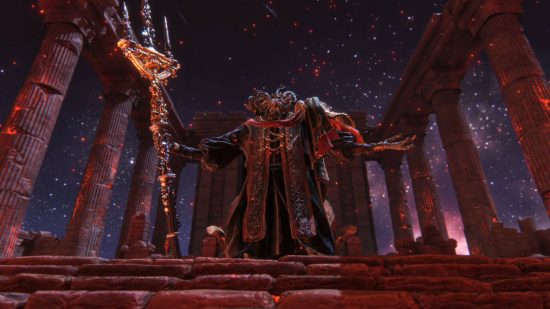Elden Ring is more than just a brilliant open world game – it marks the renaissance of the genre. For decades, the focus of genre developers has been on adding details – creating the perfect universe in which players can explore whatever they want – and this “more is more” approach has been more or less successful. For every Grand Theft Auto city teeming with quests, shops, golf courses, and bowling alleys, or for every Elder Scrolls region teeming with dungeons to explore, there are bland depictions of real-life locations that may provide just the right detail but end up feeling rather bland. boring. and chubby.
Of course, the most obvious punching bags are all of Ubisoft’s recent open-world games. Almost all of Assassin’s Creed make sense for an open world, since they take place in actual locations from the story, but Ubisoft has added open worlds (or very large maps) to several of its other series with mixed results. Far Cry, Watch Dogs, and Tom Clancy’s Ghost Recon all have huge islands or towns to explore, but there aren’t that many. inside them, plus millions of useless collectibles that will eventually give you an achievement.
Even the post-Assassin’s Creed reboot games, which are by far Ubi’s most successful open-world games, are taking a lot of flak for feeling like less-immersive imitations of Rockstar’s great games. This is an often-ridiculed image for Ubisoft games, and thankfully the developer is trying to avoid it.
So 2022 didn’t have Ubisoft’s newest open-world adventure to compare to, but plenty of other developers tried. Elden Ring deserved all the praise, but the same can’t be said for the Saints Row reboot, which didn’t make much of an impact, much like Gotham Knights later that year. These two games are perfect examples of the failure of the “more is more” approach: the developers tried to create maximalist open worlds, and instead we got boring cities with almost nothing to do. . Things are a little better in Sonic Frontiers, despite having a completely open world to explore for the first time, but at times it still feels like a featureless void filled with collectibles and little else.
Elden Ring is a revolutionary exception. Using features found in games like Dark Souls, FromSoftware redefines the open-world genre in a new way, illuminating a different take on the maximalist ethos that only Rockstar has managed to achieve. Sure, it helps that Elden Ring is inherently a challenging game that increases the time it takes to explore the Middle Lands, but there are other reasons why it managed to become one of the best in the genre without trying to follow Rockstar’s script. .

The most important lesson we can all learn from Elden Ring is that a quality experience requires sure oven time. It’s pretty common to rush a game out in time to satisfy shareholders – just look at Cyberpunk 2077 – but the most successful examples of the genre are the ones where the developers have plenty of time to perfect everything.
In particular, cross-platform games often take much longer to complete, as studies look at numerous hardware optimizations for PC and different console generations. After all, getting such a complex card to work properly on all devices is a Herculean task for the assigned QA teams, but Elden Ring works well even on a Steam framed platform.

The real secret to Elden Ring is the challenge of integrating the unique way these games tell their stories, as well as Souls-like combat and bosses, into an open world environment. This was definitely the biggest hurdle FromSoftware had to face. Too many games explain everything in expository dumps instead of allowing the player to experience the world on their own. Along with the new open-world setting, FromSoftware’s method of trickling your way through item descriptions for powerful relics adds to that joy when you find something buried in a seemingly inconspicuous corner of the map. Unfortunately, this is a gimmick that Sonic Frontiers lacks, as Eggman’s journals contain plot elements that, if found on the island with other major updates, would be useful to uncover. Instead, you just trade them in for the fish you win in the fishing minigame, which isn’t all that exciting.
One strange benefit of Elden Ring’s open-world design is that while repetitive boss fights are a common complaint in regular Souls games, the same sorts of rematches against familiar bosses are some of Elden Ring’s best moments. They come with customizations like adding regular enemies or pairing them with another boss. Take, for example, Godskin Duo. You’ve fought Divineskin Apostle and Divineskin Noble before, and they’re formidable on their own. However, by sharing a criminally high health bar, you have to kill them repeatedly. They’re far from the most demanding bosses in the Elden Ring, but with these changes, it’s one of the most memorable encounters and a talking point when someone asks about your progress.

This brings me to a more controversial point: reusable resources can improve your game if you know how to use them correctly. Elden Ring doesn’t just do that with bosses; it also includes tombs filled with grotesque imps that await you as you move through fiery traps, pits filled with poisonous water, and pressure plates that shoot arrows from walls when you step on them. No design is a complete cut and paste, although sometimes it is very close. On the other hand, many of Saints Row’s locations and quests seem to be repetitive in their design and layout, which contributes to its bland presentation.
Giving purpose to everything is hard, so doing it in a kind of open world that by definition lends itself to being global rather than focused should be next to impossible. Elden Ring has a few flaws, as bugs are always overlooked, but there’s so much good about its design that it should be a reference for anyone trying to create meaningful experiences in a type that lends itself. to wander
Rockstar may be the only developer on the planet with the endless money and attention to detail it takes to make sense on both the macro and micro scales of a vast open world, but most other developers in the genre followed suit. screenplay. The results are predictable: with the possible exception of The Witcher 3 and (after some work) Cyberpunk, no one else came close. For years we’ve needed a game like Elden Ring to show us a new path.
Hopefully in the next five years we’ll have an open world game as monumental as Elden Ring that understands why it was so good before making it better in every way. In fact, it would take that long for someone to usurp him from a high throne.
Source : PC Gamesn

